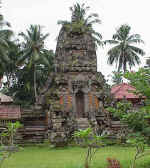Special Days and Festivals
Galungan
Galungan a celebration of the creation of the universe, in which the Supreme God Creator of the Universe, is worshiped and all ancestral spirits are called to come down to earth and dwell again in the homes of their descendants. Welcoming offerings are placed in the family shrines and graceful “Penjor”, tall arching bamboo decorations with palm leaves and flowers as well as small bamboo alters bearing intricately woven palm leaf “Lamaks” are placed at the gate of each home. All of Bali seems to be out on the roads, everyone sporting brand-new clothes, intending to visit friends and enjoy the holiday.
Kuningan
Ten days after Galungan, this is the day on which the ancestors are bidden farewell with more offerings and freshly woven “Lamaks”, and the Barongs take to the roads driving away any evil that may be in the village.
Saraswati
A special day is devoted to Saraswati, the Goddess of learning science and literature, once a year according to the 'Wuku Calendar'. On this day no one is allowed to read or write, and offerings are made to the lontar (Palm-leaf books) and other books.
Tumpek Landep
A day most sacred to blacksmiths (Pande), when all holy weapons, metal tools and implements (even cars and motorbikes) are blessed.
Tumpek Uduh
A day on which offerings are given to fruit trees, and gardens
Tumpek Wayang
On this day all the instruments of the “Wayang Kulit” (shadow puppets) are cleaned and receive blessings.
Some Ribek
A day devoted to Batari Dewi Sri, the goddess of rice and fertility on this day the milling or selling of rice is forbidden.
Ciwa Latri
A night of penance and asking for forgiveness for past sins.
Bali Art Festival
Since 1978 the annual Bali Art Festival has taken place, from the middle of June until July. Lasting for one month, the main aim of the festival is preserving the art and culture of Bali. There are varieties of masterpieces of art from all the regencies of Bali to be presented at the festival such as: traditional music, dances, fine art and many handicrafts. The opening ceremony of the festival is quite interesting and is followed by one kilometer long grand colorful parade. The parade starts from Puputan Badung square, Denpasar, in front of the Governors Residence and finishes at Werdhi Budaya Art Center where the festival is held.
Kite Festival
Flying kites has become part of Balinese people’s traditional way of life. It is both a hobby and a sport, which involves many people regardless of their age, status or gender. More than just for fun it has a religious significance. The God “Rare Angon”, protector of crops against disease and pestilence, must be appeased by the flying of kites. The festival is has been an annual event since the first one was held in 1979. In addition to the Balinese many foreign kite flying clubs also participate. During the festival Thousands of kite lovers flood the area and fly their colorful kites of various types and sizes, adding color to the clean blue sky. While on the ground the loud and cheerful sound of Gamelan orchestras enhance the festival to make the days really alive.

